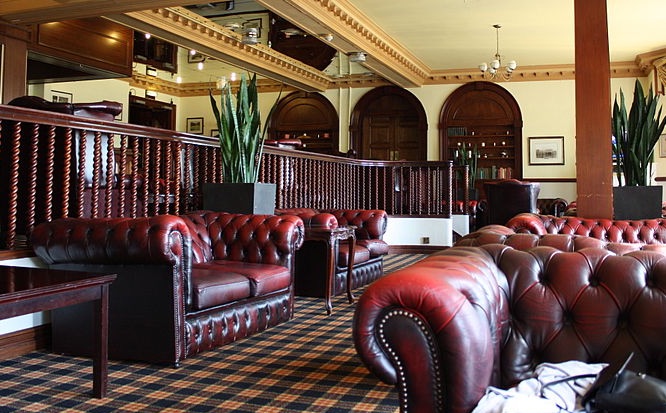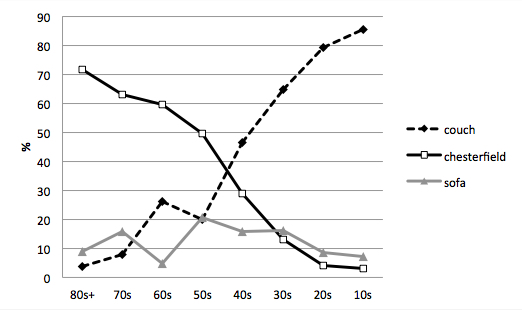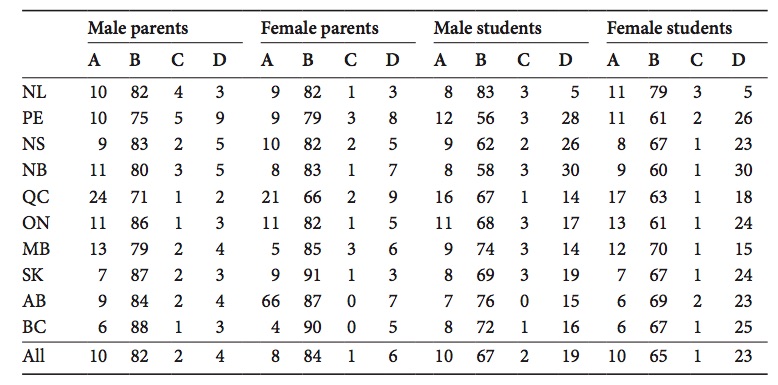DCHP-2
chesterfield [< Lord Chesterfield, probably the Fourth Earl of Chesterfield, Philip Dormer Stanhope, 1694-1773 (Chambers 1995: 157)] DCHP-2 (December 2016)
1 † n. — proprietary
a leather couch with upholstery buttons, high back and arm rests (see Image 1).
This meaning is not specifically Canadian, as it refers to an English couch style. It provided, however, the base meaning from which meaning 2 was generalized.2 n. — dated
any couch.
Type: 2. Preservation — In the earlier part of the 20th century, the term was used as a generic word for couch in many parts of the US, including California, the Upper Midwest and parts of the South, which is supported by Linguistic Atlas data (Allen 1973-76, Reed 1954) and ancedotal evidence (Chambers 1995: 156).
In the US, chesterfield 'couch' remained a regional variant but receded early in the 20th century, while in Canada over the course of the 20th century it became "the standard generic term" for a couch (Chambers 1995: 157). The dated quotations help to draw a time line: the couch in the 1915 quotation, sold at $2.50 (and compared with the $85 price for a Chesterfield, see the 1918 quotation in meaning 1), was not the leather version, but an early generic use of the term. The generalization from one type of couch to any couch has been linked to newly-arrived immigrants in the pre-WWI period, who may have learned the term while working in domestic service, where they would have been exposed to the term Chesterfield. The semantic generalization from one type of couch to any type of upholstered bench is plausible (Dollinger 2015b: 88-95).
Chart 1 shows the recessive use of the term in the Greater Toronto Region with data from the early 1990s. By then, people in their twenties would prefer couch (c. 80% range) over chesterfield (less than 5%) and sofa (about 10%), while the older generations prefer chesterfield. Given the American uses early on, the term can be considered a preservation from US English, or, alternatively, a semantic change from the original meaning.
The decline of the form started in the 1960s (when the 50s in Figure 1 were about 20 years old), but the 1970s were likely the period of rapid change towards couch. In Chart 2, data from the 1971 Survey of Canadian English (Scargill & Warkentyne 1972) shows that option B (chesterfield) is still quite high in both parents and Grade-9 students (option A: sofa, option C: davenport, option D: other), but lower in the students.
Gregg (1973), however, found survey evidence that in the early 1970s in BC, chesterfield was named in only 40% of cases, while couch fared better with 56%. He concluded that “the preferred General Canadian (GC) form chesterfield has lost ground heavily to couch” (1973:108). We can therefore say that from about the 1920s to the 1970s chesterfield was the standard Canadian variant, after which it was replaced by couch.- Walter S. Avis tells this anecdote relating to chesterfield 'couch':
"Not long ago a Torontonian shopping in a large department store just across the border [in the US] asked where he could find chesterfields. On following directions, he was somewhat dismayed to find himself at the cigar counter!" (Avis 1954: 13) - As a general guide, upper case spellings refer to the proprietary meaning 1 (but see the 1915 quotation below for an exception). Lower case spellings usually refer to generic meaning 2.
References:
Images:

Image 1: Hotel lobby with Chesterfield couches. Source: Wikimedia Commons. Photo: Ardfern
Chart 1: Chesterfield and competitors in the Greater Toronto Area, 1991/2 (data: Chambers 1995)
Chart 2: Chesterfield (option B) in percent by province (Scargill & Warkentyne 1972: 86)